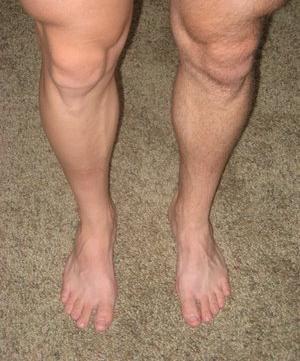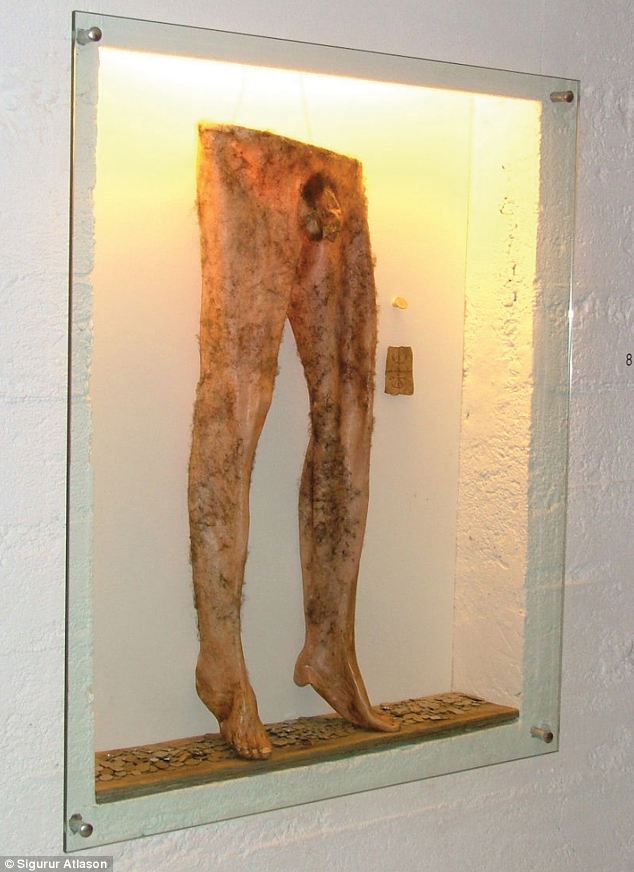Human Trousers from Iceland April 8, 2014
Author: Beach Combing | in : Modern , trackbackRegular readers of this blog will know the name ‘Leif’, who always sends in excellent copy about Viking culture, correcting my excesses and offering new perspectives. Leif recently sent in these reflections on Lappish breeches (extraordinary and horrific picture at the foot of this post) after my post on a human drum. Here we return to an old theme often covered in this blog of the apparent magical qualities of the Lapps. In any case, Leif quotes from Jon Arnason. [Islenzkar thjodsögur og æfintyri (Icelandic folktales and legends) Leipzig: J.C.Hinrichs, 1862. volume 1, pp 428-9 and Jacqueline Simpson’s translation of the same: . Icelandic folktales and legends. Berkeley: University of California press. 1972 pp 167-9]
People who wanted to gather money that would never fail them used to get themselves breeches called Old Nick’s Breeches, or sometimes also Lappish Breeches (as Lapps are famous wizards), or Money Breeches, Corpse Breeches, or Papey Breeches (because the men on Papey Isle used to be so rich that it was thought uncanny). A man who wants to have such breeches must make an agreement with someone still alive that as soon as the latter dies, he can have the use of his skin. As soon as this happens, the survivor goes to the churchyard by night and digs the dead man up. He then flays the skin off him from the waist down and slips it off in one piece, for he must take care that there is no hole in the breeches. He must put them on straight away, and they will grow to his flesh until he himself removes them in order to give them to someone else. But before the breeches can be of any use, he must first steal a coin from some wretchedly poor widow, at the moment between the reading of the Epistle and the Gospel on one of the three major church festivals of the year (or else, some say, on the next day after he puts them on), and put this coin in the pocket of them. After this, the breeches will draw money from living men, so that the pocket is never empty whenever their owner puts his hand in it; but he must take care never to take the stolen coin out.
It is very facile but as often when reading about folk magic I can’t help visualizing the episodes. Men with skin trousers in a small Icelandic church scrambling between the widows and the collection plate. Arnason continues:
A point worth noting about Lappish Breeches is that a man who has them cannot take them off or get rid of them just when he likes, but on the other hand the whole salvation of his soul depends on his doing so before he dies, not to mention the fact that his corpse will be all swarming with lice if he dies still wearing them. His one chance is to find someone who will step into them as he takes them off, and even so the only way he can do it is to step out of the right leg only at first, and for the man who has accepted them to step into it at once. As soon as he has done this, the new owner cannot change his mind even if he wants to, for if he tries to take his right leg out he will only find that he has put his left leg in without knowing how this happened. Then he in tum can never get rid of them except by the same method. Lappish Breeches keep their powers as they pass from man to man, and they never get torn.
Here, of course, we have a common folklore motif of the man who must pass a devilish burden on before dying: I seem to recall a Le Fanu short story… Leif with his normal thoroughness includes two footnotes. One from Arnason’s 1862 edition: ‘Mensalder the Rich, who lived on Papey and died in 1799, was believed by his contemporaries to have owned such breeches and to have vanished at sea in a sudden squall because he could not bear to part with them .(J.A. I 429).’
The other from Simpon:
It was also held that shoes of human skin would never wear out unless one trod on consecrated ground in them (J.A. 1443-4); magic gloves of human skin are also mentioned (J.A. 1543); for the Witch’s Bridle, see pp. 180-1. Similar ideas about the possible evil use of a corpse’s skin may once have been known in England. There is a legend recorded from two different parts of Devonshire of a wicked squire who sold not his soul but his skin (posthumously) to the Devil; when the Devil tried to flay the corpse, he found the skin full of holes, and hence useless to him (Notes and Queries Series I, vol. III, 1851, 404; Tickler, Dartmoor and its Borders, 2nd ed. 1871, 117- 18; cf. Briggs 1971, I 56, 153). In a Norwegian tale (Christiansen 1964, 162-4), the Devil flays a corpse and wants to carry off the skin to prove that the dead man belonged to him; a boy tricks him out of the skin on the plea that he wants to make shoes of it.
Leif also continues his longstanding interest in the origins of the word Lapp.
The Icelandic word is ‘Finnabrækur’, which is literally translated to ‘Lappish Breeches’. Sveinsson states (p 193): ‘Next we come to belief in Finn-breeches… Of these [kinds of things] I know no stories until very late in time.’He then cites a two source from the late 1600s. This is 400 odd years later than Vatnsdaela Saga, the source for your ‘Medieval Shamanic Account from Iceland’ post (17 Jan 2014). Sveinsson continues (p 196):…it has been assumed that much ‘Finnish’ magic is of Norwegian origin.’ Simpson’s parenthetical ‘as Lapps are famous wizards’ (above) doesn’t appear in Arnason’s original text. This implies that Icelanders in the 1860s associated Sami with sorcery, despite limited contact between the two peoples over a number of centuries.’
I found this particularly interesting, though it is so difficult to demonstrate these things.
In Norway, the theme appears only fairytales (as far as I am aware), while the version above is practically a recipe. If the story is really Norwegian in origin, this indicates a cultural divergence which would take considerable time.The theme quite possibly predates Christianity.
When someone of Leif’s erudition says ‘possibly predates Christianity’, this is the equivalent of ‘creepy music’ coming on in a slasher film. I would have dedicated this post to Leif had it not been impertinent given that he wrote the whole thing!
Note for Sveinsson, Einar Òlafur. Benedikz, Benedikt (translator).The folk stories of Iceland London: Viking society for northern research, university college. 2003 Interview
Here at the end is a photograph of Lappish trousers from the Strandagaldur: the museum of icelandic sorcery and witchcraft. In my prudish way I’ve kept it to the end so, should you be having a bad day, you can now just click away. Be warned I can’t get the image (from the Mail) out of my head.




